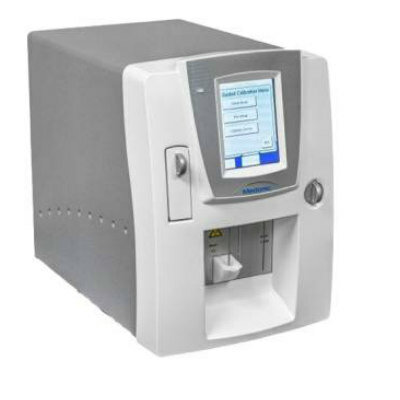Blood and Urine Metabolic Biomarkers Monitor Short-term Dietary Changes
|
By LabMedica International staff writers Posted on 04 Nov 2019 |

Image: Researchers have identified several chemical signatures, detectable in blood and urine, that can accurately measure dietary intake (Photo courtesy of Medical Xpress).
Metabolites found in plasma and urine samples may serve as responsive biomarkers reflecting short-term changes in the habitual diet.
Unhealthy eating patterns have been linked to the increase in obesity and related chronic diseases such as diabetes worldwide. However, existing methods of assessing dietary intake in nutritional epidemiology rely on food frequency questionnaires or dietary records that are prone to bias and selective reporting.
To improve this situation, investigators at McMaster University (Hamilton, ON, Canada) sought to identify metabolites in readily accessible blood or urine samples that would reflect short-term changes in dietary intake. Measurement of those markers would be used to compare the foods provided to study participants to what they reported they had eaten.
Over the course of this study, metabolic phenotyping was performed on 42 healthy participants from the Diet and Gene Intervention (DIGEST) pilot study, a parallel two-arm randomized clinical trial that provided complete diets to all participants. Matching single-spot urine and fasting plasma specimens were collected at baseline, and then following two weeks of either a Prudent or Western diet with a weight-maintaining menu plan designed by a dietician. The Prudent diet was rich in fruits, vegetables, lean meats, and whole grains. The Western diet was rich in trans fats, processed foods, red meat, and sweetened beverages. Targeted and nontargeted metabolite profiling was conducted for two weeks using three complementary analytical platforms.
A modest reduction in systolic and diastolic blood pressure, and total cholesterol was reported for participants following the Prudent diet after two weeks as compared to the Western diet; however, dietary adherence relied on participant self-reporting, and food preparation methods were not standardized.
Overall, 3-methylhistidine and proline betaine concentrations increased in both plasma and urine samples after participants were assigned a Prudent diet with a corresponding decrease in the Western diet group. Similarly, creatinine-normalized urinary imidazole propionate, hydroxypipecolic acid, dihydroxybenzoic acid, and enterolactone glucuronide, as well as plasma ketoleucine and ketovaline increased with a Prudent diet after adjustments for age, sex, and BMI. In contrast, plasma myristic acid, linoelaidic acid, linoleic acid, alpha-linoleic acid, pentadecanoic acid, alanine, proline, carnitine, and deoxycarnitine, as well as urinary acesulfame K increased among participants following a Western diet. Most metabolites were also correlated to changes in the average intake of specific nutrients from self-reported diet records reflecting good adherence to assigned food provisions.
"We were able to detect short-term changes in dietary patterns which could be measured objectively," said senior author Dr. Philip Britz-McKibbin, professor of chemistry and chemical biology at McMaster University. "And it did not take long for these significant changes to become apparent. This has been a major issue in nutritional research and may be one of the main reasons for the lack of real progress in nutritional sciences and chronic disease prevention."
The dietary biomarker study was published in the October 9, 2019, online edition of the journal Nutrients.
Related Links:
McMaster University
Unhealthy eating patterns have been linked to the increase in obesity and related chronic diseases such as diabetes worldwide. However, existing methods of assessing dietary intake in nutritional epidemiology rely on food frequency questionnaires or dietary records that are prone to bias and selective reporting.
To improve this situation, investigators at McMaster University (Hamilton, ON, Canada) sought to identify metabolites in readily accessible blood or urine samples that would reflect short-term changes in dietary intake. Measurement of those markers would be used to compare the foods provided to study participants to what they reported they had eaten.
Over the course of this study, metabolic phenotyping was performed on 42 healthy participants from the Diet and Gene Intervention (DIGEST) pilot study, a parallel two-arm randomized clinical trial that provided complete diets to all participants. Matching single-spot urine and fasting plasma specimens were collected at baseline, and then following two weeks of either a Prudent or Western diet with a weight-maintaining menu plan designed by a dietician. The Prudent diet was rich in fruits, vegetables, lean meats, and whole grains. The Western diet was rich in trans fats, processed foods, red meat, and sweetened beverages. Targeted and nontargeted metabolite profiling was conducted for two weeks using three complementary analytical platforms.
A modest reduction in systolic and diastolic blood pressure, and total cholesterol was reported for participants following the Prudent diet after two weeks as compared to the Western diet; however, dietary adherence relied on participant self-reporting, and food preparation methods were not standardized.
Overall, 3-methylhistidine and proline betaine concentrations increased in both plasma and urine samples after participants were assigned a Prudent diet with a corresponding decrease in the Western diet group. Similarly, creatinine-normalized urinary imidazole propionate, hydroxypipecolic acid, dihydroxybenzoic acid, and enterolactone glucuronide, as well as plasma ketoleucine and ketovaline increased with a Prudent diet after adjustments for age, sex, and BMI. In contrast, plasma myristic acid, linoelaidic acid, linoleic acid, alpha-linoleic acid, pentadecanoic acid, alanine, proline, carnitine, and deoxycarnitine, as well as urinary acesulfame K increased among participants following a Western diet. Most metabolites were also correlated to changes in the average intake of specific nutrients from self-reported diet records reflecting good adherence to assigned food provisions.
"We were able to detect short-term changes in dietary patterns which could be measured objectively," said senior author Dr. Philip Britz-McKibbin, professor of chemistry and chemical biology at McMaster University. "And it did not take long for these significant changes to become apparent. This has been a major issue in nutritional research and may be one of the main reasons for the lack of real progress in nutritional sciences and chronic disease prevention."
The dietary biomarker study was published in the October 9, 2019, online edition of the journal Nutrients.
Related Links:
McMaster University
Latest Molecular Diagnostics News
- Ultra-Sensitive Blood Biomarkers Enable Population-Scale Insights into Alzheimer’s Pathology
- Blood Test Could Predict Death Risk in World’s Most Common Inherited Heart Disease
- Rapid POC Hepatitis C Test Provides Results Within One Hour
- New Biomarkers Predict Disease Severity in Children with RSV Bronchiolitis
- CTC Measurement Blood Test Guides Treatment Decisions in Metastatic Breast Cancer Subtype
- Multiplex Antibody Assay Could Transform Hepatitis B Immunity Testing
- Genetic Testing Improves Comprehensive Risk-Based Screening for Breast Cancer
- Urine Test Could Reveal Real Age and Life Span
- Genomic Test Identifies African Americans at Risk for Early Prostate Cancer Recurrence
- Blood Test Could Identify Biomarker Signature of Cerebral Malaria
- World’s First Biomarker Blood Test to Assess MS Progression
- Neuron-Derived Extracellular Vesicles Could Improve Alzheimer’s Diagnosis
- Sample Prep Instrument to Empower Decentralized PCR Testing for Tuberculosis
- Endometriosis Blood Test Could Replace Invasive Laparoscopic Diagnosis
- World's First NGS-Based Diagnostic Platform Fully Automates Sample-To-Result Process Within Single Device
- Rapid Diagnostic Breakthrough Simultaneously Detects Resistance and Virulence in Klebsiella Pneumoniae
Channels
Clinical Chemistry
view channel
Blood Test Could Predict and Identify Early Relapses in Myeloma Patients
Multiple myeloma is an incurable cancer of the bone marrow, and while many patients now live for more than a decade after diagnosis, a significant proportion relapse much earlier with poor outcomes.... Read more
Compact Raman Imaging System Detects Subtle Tumor Signals
Accurate cancer diagnosis often depends on labor-intensive tissue staining and expert pathological review, which can delay results and limit access to rapid screening. These conventional methods also make... Read moreHematology
view channel
MRD Tests Could Predict Survival in Leukemia Patients
Acute myeloid leukemia is an aggressive blood cancer that disrupts normal blood cell production and often relapses even after intensive treatment. Clinicians currently lack early, reliable markers to predict... Read more
Platelet Activity Blood Test in Middle Age Could Identify Early Alzheimer’s Risk
Early detection of Alzheimer’s disease remains one of the biggest unmet needs in neurology, particularly because the biological changes underlying the disorder begin decades before memory symptoms appear.... Read more
Microvesicles Measurement Could Detect Vascular Injury in Sickle Cell Disease Patients
Assessing disease severity in sickle cell disease (SCD) remains challenging, especially when trying to predict hemolysis, vascular injury, and risk of complications such as vaso-occlusive crises.... Read more
ADLM’s New Coagulation Testing Guidance to Improve Care for Patients on Blood Thinners
Direct oral anticoagulants (DOACs) are one of the most common types of blood thinners. Patients take them to prevent a host of complications that could arise from blood clotting, including stroke, deep... Read moreImmunology
view channel
Ultrasensitive Liquid Biopsy Demonstrates Efficacy in Predicting Immunotherapy Response
Immunotherapy has transformed cancer treatment, but only a small proportion of patients experience lasting benefit, with response rates often remaining between 10% and 20%. Clinicians currently lack reliable... Read more
Blood Test Could Identify Colon Cancer Patients to Benefit from NSAIDs
Colon cancer remains a major cause of cancer-related illness, with many patients facing relapse even after surgery and chemotherapy. Up to 40% of people with stage III disease experience recurrence, highlighting... Read moreMicrobiology
view channel
New UTI Diagnosis Method Delivers Antibiotic Resistance Results 24 Hours Earlier
Urinary tract infections affect around 152 million people every year, making them one of the most common bacterial infections worldwide. In routine medical practice, diagnosis often relies on rapid urine... Read more
Breakthroughs in Microbial Analysis to Enhance Disease Prediction
Microorganisms shape human health, ecosystems, and the planet’s climate, yet identifying them and understanding how they are related remains a major scientific challenge. Even with modern DNA sequencing,... Read morePathology
view channel
Genetics and AI Improve Diagnosis of Aortic Stenosis
Aortic stenosis is a progressive narrowing of the aortic valve that restricts blood flow from the heart and can be fatal if left untreated. There are currently no medical therapies that can prevent or... Read more
AI Tool Simultaneously Identifies Genetic Mutations and Disease Type
Interpreting genetic test results remains a major challenge in modern medicine, particularly for rare and complex diseases. While existing tools can indicate whether a genetic mutation is harmful, they... Read more
Rapid Low-Cost Tests Can Prevent Child Deaths from Contaminated Medicinal Syrups
Medicinal syrups contaminated with toxic chemicals have caused the deaths of hundreds of children worldwide, exposing a critical gap in how these products are tested before reaching patients.... Read more
Tumor Signals in Saliva and Blood Enable Non-Invasive Monitoring of Head and Neck Cancer
Head and neck cancers are among the most aggressive malignancies worldwide, with nearly 900,000 new cases diagnosed each year. Monitoring these cancers for recurrence or relapse typically relies on tissue... Read moreTechnology
view channel
Pioneering Blood Test Detects Lung Cancer Using Infrared Imaging
Detecting cancer early and tracking how it responds to treatment remains a major challenge, particularly when cancer cells are present in extremely low numbers in the bloodstream. Circulating tumor cells... Read more
AI Predicts Colorectal Cancer Survival Using Clinical and Molecular Features
Colorectal cancer is one of the most common and deadly cancers worldwide, and accurately predicting patient survival remains a major clinical challenge. Traditional prognostic tools often rely on either... Read moreIndustry
view channel
BD and Penn Institute Collaborate to Advance Immunotherapy through Flow Cytometry
BD (Becton, Dickinson and Company, Franklin Lakes, NJ, USA) has entered into a strategic collaboration with the Institute for Immunology and Immune Health (I3H, Philadelphia, PA, USA) at the University... Read more


















